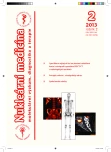-
Medical journals
- Career
Ewing sarcoma - scintigraphic image
Authors: Jana Páterová; Jaromír Bernátek; Blanka Kadlčíková
Authors‘ workplace: Oddělení nukleární medicíny, Krajská nemocnice T. Bati, a. s., Zlín
Published in: NuklMed 2013;2:31-35
Category: Casuistry
Overview
Aim:
To present the scintigraphic image of Ewing sarcoma in a 15-years-old girl.Methods:
15-years-old girl without specific family history of disease was admitted to a regional hospital having various problems such as fatigue, a lack of appetite, weight loss, pain in her joints and bones. According to the laboratory tests infection parameters were: CRP 160 mg/l, FW 120/128 and anemia. The patient underwent three phase bone scintigraphy to exclude the possibility of infection in the right sacroiliac area. The patient weight was 59,5 kg. Applied activity of the 99mTc-methylendiphosphonate (MDP) was 750 MBq. The scintigraphy started 10 minutes after an intravenous injection of the radiotracer. Three hours later started whole body scintigraphy using dual-head SPECT gamma camera AXIS PICKER with low-energy, high resolution, parallel-hole collimators.Results:
In the third phase scintigraphy demonstrated significantly patchy increased accumulation in the axial skeleton, in the occipital region of the cranium, in both coxal joints and in the left fibula. This result suggested hematologic malignancy. The patient was referred to Department of Hematooncology Olomouc University Hospital. MRI of the skeletal system and an examination of bone marrow were done there. Cells of Ewing sarcoma were found. This clinical diagnosis was confirmed in the Department of Oncology in Brno. It was considered that the primary tumor was the left fibular lesion.Conclusion:
The three-phase bone scintigraphy demonstrates important role of high sensitive nuclear medicine methods in the diagnostics of disease in children. The result significantly changed the clinical approach in this case.Key Words:
three–phase bone scintigraphy, 99mTc-methylendiphosphonate, hematologic malignancy, Ewing sarcoma
Sources
1.Hušák V, Petrová K, Masopust J et al. Aplikované aktivity radiofarmak, radiační zátěž a radiační riziko vyšetřovacích postupů v nukleární medicíně. Cas Lek Cesk 1999;138 : 323-328
2.Skotáková J, Mach V, Bajčiová V et al. Maligní tumory dlouhých kostí u dětí, diferenciální diagnostika, přínos zobrazovacích metod. Acta Chir Orthop Traumatol Cech. 2006;73 : 183-189
3.Vižďa J, Křížová H, Urbanová E. Atlas kostní scintigrafie. Praha. Lacomed 2006 : 71
4.Mottl H. Ewingův sarkom a osteosarkom. Sanquis 2007;51 : 18
5.Adámková Krákorová D, Tuček Š, Tomášek J et al. Léčba Ewingova sarkomu/periferního neuroektodermálního tumoru dospělých. Onkologie 2012;6 : 91-94
6.Cousins JP, Blend MJ. MDP Bone Scan: a Key Step in Assessment and Staging of a Rare Presentation of Ewing sarcoma in a Young Adult Man. The Internet Journal of Nuclear Medicine 2012;3 : 1-5
7.Davies A, Makwana N, Grimer R et al. Skip metastases in Ewing‘s sarcoma: a report of three cases. Skeletal Radiol 1997;26 : 379-384
8.Dupal P, Křížová H. Scintigrafie skeletu v diagnostice kostních nádorů. Zdravotnické noviny ZDN Příloha Lékařské listy LL 2000;31 : 2
Labels
Nuclear medicine Radiodiagnostics Radiotherapy
Article was published inNuclear Medicine

2013 Issue 2
Most read in this issue- Ewing sarcoma - scintigraphic image
- Brief overwiev of individually prepared radiopharmaceuticals in laboratory on KNME FN Motol Prague
- Specification of Equivocal Lesions in Planar Whole Body Bone Scintigraphy with SPECT/CT in Oncological Patients
- What can you see on the image?
Login#ADS_BOTTOM_SCRIPTS#Forgotten passwordEnter the email address that you registered with. We will send you instructions on how to set a new password.
- Career

